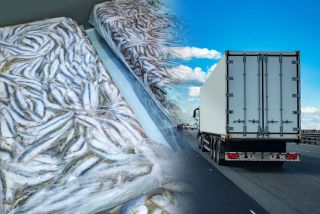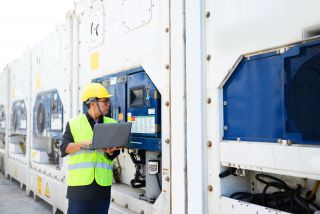What is a Refrigerated Container? Types, Features, & Safety
APRIL 3, 2021 BY

The first Refrigerated Container was introduced around 40 years ago. Also known as reefers, these insulated containers were used to ship temperature-sensitive products over long distances.
Today, restaurants, farming operations, and packing houses can look to refrigerated containers for onsite uses. These industries have begun using refrigerated shipping containers as coolers or freezers. These units can help satisfy temporary storage needs during renovations, additional storage during seasonal peaks, and increased storage capacity.
Types of Refrigerated Shipping Containers

There are a variety of refrigerated units on the market today. These containers differ depending on condition, efficiency requirements, and the cargo they need to carry.
One-Trip Containers
One-trip reefers have made just one trip across the ocean. Because of their limited use, they're often marketed as "as good as new." These units will arrive in excellent condition, with all sections working reliably. These containers should be able to achieve extremely cold temperatures.
Used Containers
Used containers are a more affordable option for businesses without the funds to invest in a new or one-trip container. Though they have likely sustained some wear and tear throughout their lifetime, these units should be fully functional. It is crucial to inspect the unit before purchase to ensure the cargo doors open easily, the unit is working properly, and the conditions are cold enough to store perishables.
Closed Reefer Containers
A closed refrigerated shipping container is a single container with an automatic heating and cooling system which runs exclusively on electricity.
Modified/Controlled Atmosphere(MA/CA) Containers
These containers use an air exchange system to maintain a proper atmosphere for goods stored inside. MA/CA reefers are also heavily insulated.
Automatic Fresh Air Management (AFAM) Containers
AFAM reefers use advanced technology to automatically regulate the air exchange within the unit to maintain a constant temperature. Users can adjust controls to influence or extend the shelf life of the goods stored inside.
Refrigerated Container Features
There is a wide variety of shipping containers available on the market to accommodate different kinds of cargo. Check out the list below to learn more about what makes refrigerated shipping containers unique.
1. Temperature
Refrigerated containers are capable of controlling temperatures ranging from -30°C and +30°C. Unlike other shipping containers, reefers contain the refrigeration equipment needed to store perishables and frozen goods.
2. Size
Reefers are most widely available in twenty-foot units, or the standard size for shipping containers. Though, it is possible to access them in different sizes. Forty and forty-five-foot units are available. High cube accommodations are also possible.
3. Material
Most often, refrigerated shipping containers are built from Corten Steel, also known as weathering steel. Because this is a corrosion-resistant material, it allows refrigerated units to be stacked alongside regular containers and provides them with high levels of strength.
4. Power
A reefer container requires an external power supply to provide cooling electricity. Most containers can receive electrical power from the ship during sea transport. On land, cold storage units are powered by diesel generations known as "gen sets." Most often, the electricity service needed is high voltage three power.
5. Refrigerant
Similar to refrigerators, reefers rely on a thermodynamic process known as the vapor-compression cycle. The operation revolves around specific components, including a compressor, condenser, evaporator, and expansion valve.
6. Insulated Walls
The walls found on these refrigeration units are essentially sandwiched between stainless steel panels located on both sides of the insulation. While standard cargo containers come with plumbing and electrical lines concealed within the interior walls, electrical outlets, and plumbing fixtures must be mounted on the walls of a reefer container.
7. Aluminum Floors
Unlike traditional containers, which have smooth metal or plywood floors, refrigerated containers contain aluminum floors. This material exists within a flooring system that includes a T-shaped profile. This design keeps the contents of the container elevated so that cold air can circulate underneath. It allows for forklift traffic.
Refrigerated Container Safety Precautions

With the ability to achieve such low temperatures, it is essential to be extremely cautious when operating a reefer container. Follow the manufacturer's recommendations when handling these containers, and remember to use personal protection equipment like glasses and safety gloves at all times. Other precautions include:
- Keep hands, clothing, and tools away from the fan when it's in motion
- Always work in a well-ventilated area
- Disconnect the power source before making repairs
- Use a CO2 extinguisher to put out flames should they occur
- Do not bypass any electrical safety device
Common Problems with Refrigerated Containers
The most common problem associated with refrigerated shipping containers revolves around leakage. This is almost always caused by bad seals around the openings, which allow air to escape.
Damage to pressure lines can also result from regular wear and tear. Electrical malfunctions and weakened refrigerants aren't uncommon either, especially after extended use.
Fortunately, simple fixes are usually able to resolve these issues. Contact a professional technician to perform regular maintenance and make repairs.
Meet Your Shipping Container Needs With Mobile Modular Portable Storage
Mobile Modular Portable Storage can assist with all your commercial space needs. Our company caters to industries including construction, industrial, petrochemical, healthcare, education, government, and more. We offer a wide selection of shipping containers available for rent, lease, or sale.
As an industry leader in portable storage solutions, we offer unparalleled service excellence. Our mission is to provide customers with a portable space solution that exceeds expectations. Each product we offer is designed to meet your specific needs with a level of individual service that inspires confidence. Visit our official site for more information or request a quote.
FAQ
How does a refrigerated container work?
Refrigerated shipping containers operate in the same way as refrigerators. They contain a specific T-shape flooring system that allows cool air to flow underneath, which is why they are called "bottom air delivery" units. The design guarantees a great atmosphere and the ability to preserve cargo by providing a consistent supply and the perfect exchange of air.
Is a refrigerated container airtight?
Though refrigerated containers can be made airtight, not all are. Instead, they work to preserve perishable products by maintaining temperatures cold enough to keep them frozen.
How much does a refrigerated container cost?
A new 20' refrigerated shipping container has an average cost between $5,600 and $7,000. Used 20' refrigeration units have an average cost between $3,900 and $4,400. New 40' refrigerated containers can cost anywhere between $10,000 and $12,000.
How are refrigerated shipping containers powered?
Refrigerated containers require an external power supply to provide cooling electricity. Each unit gets electrical power from the ship during sea transport. When on land, containers receive their power through diesel generators.
